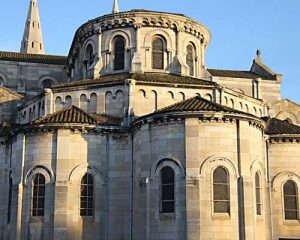 Border line between the French Kingdom and the Holy Roman Empire, from 843 to 1600. In 1790, Mâcon becomes the aministrative centre of Saône-et-Loire, and sees the birth of one of his wellknown childs: Alphonse de Lamartine (Poet and Minister). Active centre of the Resistance during World War II, Mâcon will be the first town of unoccupied France between Paris and Lyon.
Border line between the French Kingdom and the Holy Roman Empire, from 843 to 1600. In 1790, Mâcon becomes the aministrative centre of Saône-et-Loire, and sees the birth of one of his wellknown childs: Alphonse de Lamartine (Poet and Minister). Active centre of the Resistance during World War II, Mâcon will be the first town of unoccupied France between Paris and Lyon.
The urban and architectural wealth of Mâcon is witness of a past particularly rich in encounters. Mâcon town centre induces you to visit its museums and historical sites.
Apothicairerie de l’Hôtel-Dieu
The apothecary shop At the ground floor of the Hotel-Dieu hospital, build on Soufflot’s plans after 1761, the apothecary shop, or “sale-room”, has preserved its panelling of the XVIIIth century and the richness of its collection of chemistry pots: “albarelli”, “chevrettes” and others pills boxes issued from a local ceramics production.
Musée des Ursulines
This old convent was built ca. 1675 for the education of young girls, the Ursulines, issued from the middle-class. After the French Revolution, it was successively used as a prison in 1793 (where Lamartine’s father was incarcerated), a military barrack (1796-1929) and as a “House of the People” before it became the Ursulines’ museum in 1968. The department of archaeology presents the excavations lead in our city from Prehistory to Gallo-roman and medieval periods. The first floor offers an overview of the life of Mâcon, the work in the vineyard, the activities linked to the river Saône and the local artists. Finally, the second floor’s rooms present a collection of the artistic creation of the late five centuries.
Lamartine
Château de Lamartine
Saint Point feudal castle, is bought in 1801 by the father’s poet. Alphonse of Lamartine settles there in 1820 after his marriage with the English Mary Ann Birch. Restored and increased the castle will remain its family property until his death in 1869. Always remained intact and visible, furniture, objects and mémories of its private and political life, as well as the complete literaty works can be seen. At the end of the park (side of the church) the tomb of the poet topped by his motto “speravit animated mea”.
Musée de Lamartine
The Senecé Hotel, a classical town house of the XVIIIth century, shelters a museum dedicated to the life and the masterpiece of Alphonse de Lamartine, writer and politician born in Mâcon in 1790. Through drawings, engravings, sculptures, paintings and personal objects, the visitors will discover the portrait of Lamartine then his literary masterpiece which reflects his relationships with the artists of that time and his attraction for nature, his travel to the East, his political involvement and, to finish, his intimacy.
The Area
Musée de la Vigne et du Vin La Roche-Vineuse
In a building from the XVI century, you could discover our old tools from our old job, from carpenter to blacksmith, and cooper without forgetting the winemaker. Then, our wine storehouses are opened with some explication about the wine making. To finish your visit, we offer you a wine tasting in our vaulted cellar from the XVIII century.
Musée départemental de Préhistoire
The Museum of Prehistory in Solutré contains exhibits from one of the richest sites in Europe. Solutré was a hunting site for 25 000 years. Man of the Upper Palaeolithic (35 000 – 10 000 BC) trapped, killed and dismembered thousands of horses and reindeers, so leaving layers of bones. This accumulation of bones gave rise to a famous legend, which we know to be untrue, that the horses were driven over the cliff by their hunters. In fact, the herds of wild horses were ambushed and slaughtered at the foot of the cliff. Solutré have given the name “Solutrean” to a distinct culture of the Upper Palaeolithic (20 00 – 16 000 BC) which the marvellous “laurel-leaf” shaped flints have made famous.
Grottes d’Azé
The caves of Aze compose the longest arranged underground network of Burgundy. The prehistoric Cave is also the oldest habitat know in Burgundy : between 300 000 and 400 000 B.C. Worth seeing : Exceptional remnants of bears ans felines are found here. The underground river reveals the stroll of water and discloses a great geological diversity. The museum thanks to the richness of its collections, helps with the understanding of the classified site of Aze.

